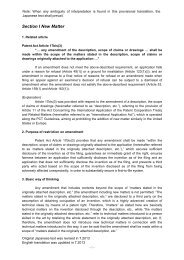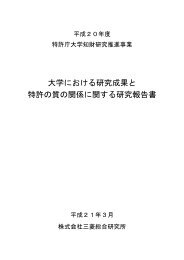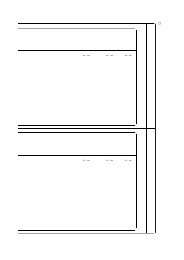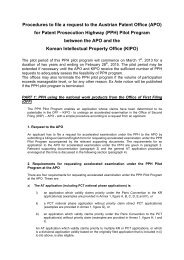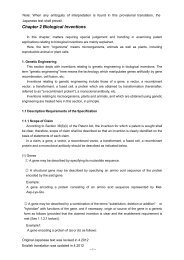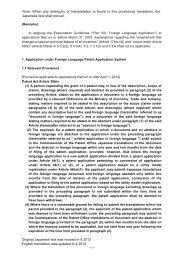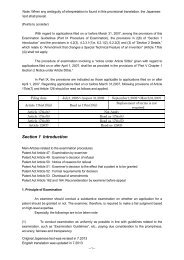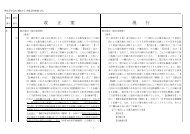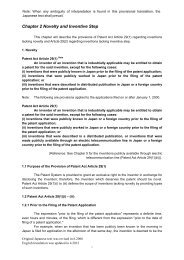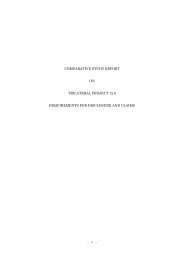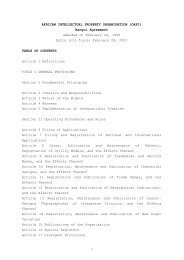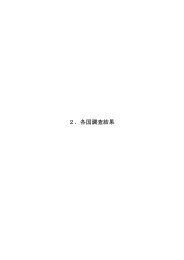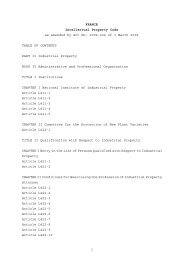Requirements for Unity of Application - Japan Patent Office
Requirements for Unity of Application - Japan Patent Office
Requirements for Unity of Application - Japan Patent Office
You also want an ePaper? Increase the reach of your titles
YUMPU automatically turns print PDFs into web optimized ePapers that Google loves.
In relation to the specified invention, the first and second related inventions satisfy the<br />
provisions <strong>of</strong> <strong>Patent</strong> Law section 37(ii) and (iii) respectively. The third related invention<br />
relates to a process <strong>for</strong> manufacturing the product <strong>of</strong> the first related invention, and hence<br />
satisfies the provision <strong>of</strong> <strong>Patent</strong> Law section 37(v) in relation to the specified invention.<br />
2. Examination on <strong>Requirements</strong> <strong>for</strong> <strong>Unity</strong> <strong>of</strong> <strong>Application</strong><br />
2.1 Basic Attitude<br />
Failure to meet the requirements <strong>for</strong> unity <strong>of</strong> application (<strong>Patent</strong> Law section 37)<br />
constitutes a reason <strong>for</strong> refusal (<strong>Patent</strong> Law section 49), but does not constitute reason <strong>for</strong><br />
opposition (<strong>Patent</strong> Law section 55) or reason <strong>for</strong> invalidation (<strong>Patent</strong> Law section 123). This<br />
is because <strong>Patent</strong> Law section 37 is a provision established <strong>for</strong> the convenience <strong>of</strong><br />
applicants, third parties and the <strong>Patent</strong> <strong>Office</strong>, and unlike other reasons <strong>for</strong> refusal, does not<br />
directly inflict serious damage to third parties if overlooked, as it concerns minor procedural<br />
deficiency in that the application should have been divided into two or more, rather than<br />
substantive faults in the invention.<br />
Accordingly, considering the purport <strong>of</strong> <strong>Patent</strong> Law section 37, it would be improper to<br />
make unnecessarily strict examination on the requirements <strong>for</strong> unity <strong>of</strong> application.<br />
2.2 Notice <strong>of</strong> Reason <strong>for</strong> Refusal<br />
Reasons <strong>for</strong> refusal concerning unity <strong>of</strong> application would occur when two or more<br />
separate inventions do not fall under the provisions <strong>of</strong> any subparagraph under <strong>Patent</strong> Law<br />
section 37. The reasons by which the inventions do not meet the requirements shall be<br />
indicated as concretely as possible.<br />
In such instances, suggestions should be made on the division <strong>of</strong> application if it is<br />
expected to facilitate response by the applicant, and thereby contribute to expediting<br />
accurate examination. It should be noted however, that such suggestions are not legally<br />
binding.<br />
When a divisional application is made on claims violating requirements <strong>for</strong> unity <strong>of</strong><br />
application as a result <strong>of</strong> notice <strong>of</strong> reasons <strong>for</strong> refusal concerning unity <strong>of</strong> application,<br />
disallowing the divisional application on grounds <strong>of</strong> identity <strong>of</strong> inventions between the<br />
original and divisional applications (against section 39) would be contrary to the purport <strong>of</strong><br />
<strong>Patent</strong> Law section 37. There<strong>for</strong>e, notice <strong>of</strong> reasons <strong>for</strong> refusal that may lead to such results<br />
shall not be made.<br />
2.3 Identification <strong>of</strong> the Specified Invention<br />
The claim corresponding to the specified invention shall be chosen to maximize the<br />
benefit to applicants, or in other words so as to recognize unity <strong>of</strong> application as broadly as<br />
possible.<br />
When there are two or more claims in the Scope <strong>of</strong> Claims, the invention described in<br />
one <strong>of</strong> the claims would be provisionally selected as the specified invention, in relation to<br />
which examination on the requirements <strong>for</strong> unity <strong>of</strong> application is to be made. If there is<br />
found as a result <strong>of</strong> the examination any claim which does not meet the requirements <strong>of</strong> the<br />
subparagraphs under <strong>Patent</strong> Law section 37, one <strong>of</strong> the other claims shall be selected one<br />
by one as the new provisional specified invention in relation to which examination on the<br />
requirements <strong>of</strong> unity <strong>of</strong> application is to be made.<br />
For example, it is considered more efficient to per<strong>for</strong>m examination on requirements<br />
under <strong>Patent</strong> Law section 37 by first selecting the invention described in a “product” claim as<br />
16



